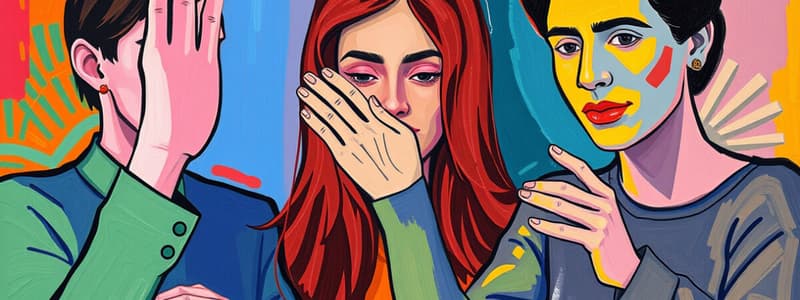Podcast
Questions and Answers
What does CL: 1 represent?
What does CL: 1 represent?
- Used for cylindrical objects
- Used for vehicles
- Used for two people walking
- Used for single individuals walking (correct)
What does CL: 2 indicate?
What does CL: 2 indicate?
- Used for two people walking (correct)
- Used for vehicles
- Used for stationary objects
- Used for thin shapes
What does CL: 3 symbolize?
What does CL: 3 symbolize?
Used for vehicles and three people walking or standing
What is CL: 4 used to represent?
What is CL: 4 used to represent?
What does CL: 5 illustrate?
What does CL: 5 illustrate?
What does CL: A show?
What does CL: A show?
What is the purpose of CL: B?
What is the purpose of CL: B?
What does CL: C represent?
What does CL: C represent?
What is CL: F used for?
What is CL: F used for?
What does CL: G describe?
What does CL: G describe?
What does CL: ILY represent?
What does CL: ILY represent?
What does CL: L signify?
What does CL: L signify?
What does CL: O represent?
What does CL: O represent?
What is the function of CL: S?
What is the function of CL: S?
What does CL: U indicate?
What does CL: U indicate?
What does CL: V illustrate?
What does CL: V illustrate?
What are the three categories of classifiers?
What are the three categories of classifiers?
What does 'Entity' represent?
What does 'Entity' represent?
What does 'Trace' do?
What does 'Trace' do?
What does 'Manipulative' refer to?
What does 'Manipulative' refer to?
What is 'Orientation' in ASL?
What is 'Orientation' in ASL?
What does 'Location' mean?
What does 'Location' mean?
What are the two types of classifiers?
What are the two types of classifiers?
What are the five parameters of ASL?
What are the five parameters of ASL?
What does 'Hand-shape' refer to?
What does 'Hand-shape' refer to?
What does 'Movement' indicate?
What does 'Movement' indicate?
What are non-manual markers?
What are non-manual markers?
How do Classifiers differ from Sasses?
How do Classifiers differ from Sasses?
What does 'Depictive' represent?
What does 'Depictive' represent?
What does 'General to Detailed' mean in sign descriptions?
What does 'General to Detailed' mean in sign descriptions?
Flashcards are hidden until you start studying
Study Notes
ASL Classifiers Overview
- Classifiers are handshapes used in American Sign Language (ASL) to represent nouns and their actions, locations, and orientations.
- Classifiers can be categorized into three types: Entity, Manipulative, and Trace.
Classifier Types
- Entity Classifiers: Represent people and objects, both large and small.
- Manipulative Classifiers: Indicate the action or movement of objects.
- Trace Classifiers: Utilize a specific hand shape to outline the shape of an object, matching its dimensions.
Specific Classifiers
- CL: 1: Represents a single person or pencil; used for individuals in motion.
- CL: 2: Used for pairs of people or thin objects like a snake tongue; indicates two entities.
- CL: 3: Signifies vehicles or groups of three people.
- CL: 4: Represents linear items such as stripes, fences, and bangs in hair.
- CL: 5: Similar to CL: 4 but can illustrate groups of five or falling leaves.
- CL: A: Depicts stationary objects like vases or bottles.
- CL: B: Represents flat surfaces like walls or tables, as well as clothing.
- CL: C: Used for cylindrical objects (e.g., cups, pipes).
- CL: F: Indicates small circular items such as coins and buttons.
- CL: G: Depicts thin shapes like bird beaks or mustaches.
- CL: ILY (Y classifier): Represents airplanes; not used for flying birds.
- CL: L: Shows the perimeter of round or square objects.
- CL: O: Represents small cylindrical objects like hoses.
- CL: S: Used to demonstrate head movements or peeking actions.
- CL: U: Indicates people and thin objects.
- CL: V: Similar to CL: 2, used for people standing or sitting.
ASL Parameters
- 5 Parameters of ASL: HOLMM - Handshape, Orientation, Location, Movement, Non-Manual Signals (facial expressions).
- Handshape: The specific configuration of hands forming the signs.
- Orientation: The direction in which the sign moves relative to the body.
- Location: The space where the sign is formed; can be stationary or mobile.
- Movement: Refers to the action of the sign across space.
Non-manual Markers & Sasses
- Non-Manual Markers: Facial expressions that enhance the meaning and grammatical structure of ASL sentences.
- Sasses: Distinct handshapes that specify size and shape; illustrate physical features and location.
General Concepts
- Depictive Classifiers: The hand takes on a shape representing the tool or instrument.
- General to Detailed: Communication flows from broader concepts to specific details, starting with overarching themes and narrowing to precise elements.
Studying That Suits You
Use AI to generate personalized quizzes and flashcards to suit your learning preferences.




